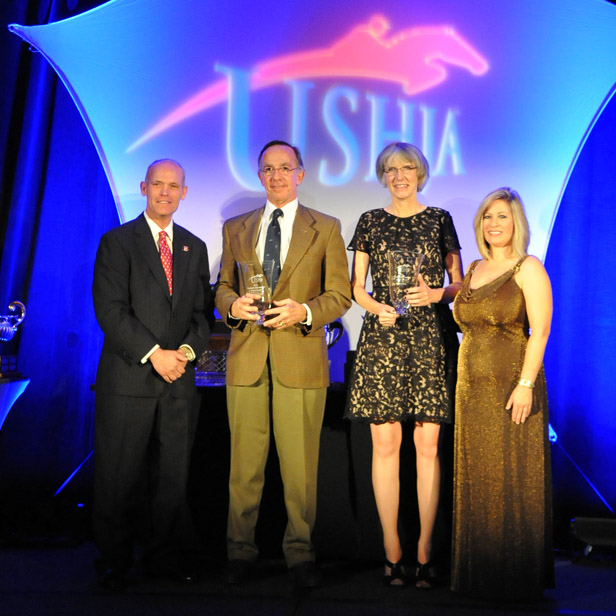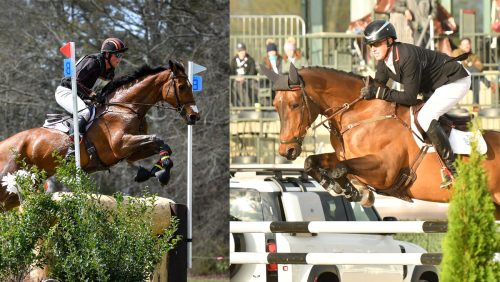Las Vegas—Dec. 11
The hot topic at the U.S. Hunter Jumper Association’s Annual Meeting is the same one that’s taken center stage at the 15 USHJA Town Hall meetings throughout the year: how to determine green hunter status. An extraordinary rule change implemented last December explicitly considered a horse’s Fédération International Equestre record to determine whether that animal may compete in pre-green or green hunter classes. But the rule proved unworkable in practice, when it became apparent that the FEI database didn’t consistently record results from smaller competitions.
With more money than ever in pre-green competition—and therefore more incentive than ever to compete an experienced horse in the division—and no method to identify a horse throughout its lifetime to cut down on horses changing identities, the USHJA is trying a new tactic. A new version of HU103.1 passed which does not consider a horse’s jumper experience in determining its green hunter eligibility. This means a European-bred horse may have competed extensively there before starting a new hunter career, and a U.S.-bred horse may compete unrestricted in the jumper ring as well before starting his career in the hunter ring.
The rule was much discussed throughout the meeting, which took place Dec. 7-11 at the Caesars Palace Hotel in Las Vegas, right up until the final vote by the Board of Directors, who passed the rule with a split vote. The rule now goes on to the upcoming U.S. Equestrian Federation Annual Meeting in Lexington, Ky., and if it passes there it will go into effect starting Dec. 1, 2015.
As soon as she introduced the rule change proposal, Mary Babick went out of her way to admit that she hardly considers a horse with several years of jumper experience “green.” The rule is largely seen as a stop-gap measure until the development of universal horse identification system, which a USEF task force been working on. An idea to restructure the hunter divisions to include a young hunter component—discussed at the meeting but not yet proposed as a rule yet—could also help pit equally-experienced horses against one another.
Oregon trainer and Board of Directors member Shelley Campf argued against “opening the floodgates to the jumpers” passionately, saying she thinks it will take away from hunter sport. But Colleen McQuay countered that the floodgates have been open for a long time, as many horses with European jumper experience have been wiping the slate clean when they come to the United States.
“The bottom line is that we can’t use the system we’ve been using,” she said. “It doesn’t work. It’s not new, it’s been that way for many years, we’re just finally saying it out loud. We’re just asking for American businesses to have the same opportunities as in Europe.”
Pony Pressure
Conversations about pony measurement also dominated the meeting rooms and hallways in Las Vegas. A Federation-prompted measurement verification at a September competition in Kentucky sparked a nationwide conversation about how to ensure that oversized ponies don’t compete in the division. While there’s long been a rule in the Rule Book that gives the USEF permission to re-measure a horse or pony at a show to ensure it measures into the correct height section, it’s rarely been used, and the Rule Book doesn’t currently outline procedures for such a re-measurement.
So the Measurement Task Force and Pony Hunter Task Forces set out to draft procedures for a Federation-prompted measurement verification measurement, not an easy task with emotions running high over fear of top-of-the-line ponies.
Pony pros pointed out that measurement is an art, not a science, and that many factors, such as shoeing, age, distractions near the measurement station can affect a pony’s height. Trainers pointed out that protest measurements are extremely disruptive during the show day to all involved, and emotions among all run very high. Thirty-year veteran steward Pam Keeler admitted that with all the pressure on stewards she’s now scared to measure.
ADVERTISEMENT
The proposed rule was tweaked all week, and ultimately referred to January’s Board of Directors meeting to allow for an updated version of the rule, which, if passed, would hit the books Dec. 1, 2015.
The rule will give competitors two options if a pony is selected for a Federation-mandated measurement verification: the pony may be re-measured at the show one hour after its last class, or the measurement may be postponed until a later date. While the latter option is still being fleshed out, the concept was met with general approval in the Pony Hunter Task Force and Measurement Task Force joint meeting.
If the exhibitor opts for verification at the show, the measurement will occur within an hour of the animal’s last class. The pony may be jogged with shoes, then have its shoes pulled before the measurement, with no other changes to the feet. The rule also allows for a ½-inch variance above the highest point in the pony’s height section. The pony may be drug tested at this time.
If the competitor opts to delay the measurement, the procedure will be stricter. The pony may not show until it has been re-measured, which USHJA President Bill Moroney suggested must take place within 30 days. There will be no height variance allowed, and the pony will be drug tested. Additionally, the owner must pay all fees associated with the delayed measurement.
“I was part of the random measurement in Lexington,” said Patty Rogers. “It was done really well. I asked a lot of questions, and all the questions were answered: What can we do before the measurement? Can we give Perfect Prep? Having said that, I agree with random measurement to a point, but I think there should be variances.
“This happened at 4:30, and we were still showing, but they gave us time,” she continued. “But this was September in Kentucky. The temperature maybe dropped 15 degrees by the time we walked up there. It was in the front of the show grounds, with semis going by. My pony was OK. Had my pony been 13.2 [hands], the correct measurement, he probably wouldn’t have measured. It was cold, it was windy, and so much was happening. I think variances are important.”
Other Rule Changes Of Note
While the rule change process for Dec. 1, 2015, isn’t finalized at the USHJA Annual Meeting—that will happen at the USEF Annual Meeting coming up in January—here’s a look at some of the most talked about rule change proposals.
Check out the latest version of all the rules discussed in Las Vegas here.
The USHJA BOD voted for a variety of new championships including an adult equitation championship, a 3’3” jumping seat medal championship, an amateur-owner hunter championship and a junior jumper championship. However, although these championships will likely enter the rule book, it doesn’t mean they’ll happen immediately.
Babick explained that while she was in favor of the new championships, they haven’t gone through a program planning process yet and would need to be prioritized due to limited USHJA resources for implementation. However, as BOD member Larry Langer pointed out, “If you create a possibility of a program and then don’t fund it or don’t support it, it’s just there. If you don’t create it, now you need a two-year rule change process. Everybody agrees that you’re going to create a program but good luck for two years. You have to put it in even if it’s unfunded and unprogrammed.”
ADVERTISEMENT
EQ 105.4, a point cap on juniors competing for U.S. Hunter Seat Medal points, stirred plenty of discussion. The intention of the rule change was to promote horse welfare by discouraging riders from competing in an excessive number of equitation classes long after they’ve qualified for the Pessoa/U.S. Hunter Seat Medal Finals.
The change to the rule would allow riders to compete with no point restrictions until June 1. Then a cap of 120 points, more than double the qualifying number for any region, would go into effect. “Any rider who willfully continues to compete after they have acquired the capped amount may be ineligible for the U.S. Hunter Seat Medal Finals,” reads the rule revision. The “may” and “willfully” were included to protect riders who might have unknowingly reached the cap due to point adjustments after the horse show or similar situations. Riders will be notified once they’ve reached the cap.
Dec. 1, 2014, issued in new C-rated divisions specifically for Thoroughbreds. HU 106.8 lays out specifications for a 3′ hunter division for Thoroughbreds, while JP 120 does the same for a 1.05-meter class for Thoroughbred jumpers. With these new classes came the feeling that the definition of Thoroughbred needed to be standardized across all the divisions, so HU 101.3 and HU 187.1, which govern hunter breeding, were updated accordingly. Some type of Jockey Club verification is required for all Thoroughbreds, which can include a tattoo, foal registration or TIP number.
Two rule change proposals regarding welcome classes at international hunter derby and national derby standalone special events, HU 189.1 and 190.1, were referred to the BOD’s January meeting. The purpose of the rule change would be to allow those classes to count toward points or money won year-end standings. Eight such special events currently exist. However, people worried that because these special events don’t have to follow the mileage rule, they could pull competitors from nearby horse shows.
Last year there was an uproar over a rule change that would allow for blood and urine samples taken at horse shows to be frozen and stored for eight years with the possibility for further drug testing at any time. The idea behind this rule change proposal is that testing technology is getting better every year, and while you might not be able to detect a forbidden substance now, later it could be possible.
This year, a similar rule change proposal to GR 402.6, 406.1 and 412.7 was greeted with more enthusiasm. This rule would only allow samples to be stored for three years. Penalties would only apply for substances forbidden at the time the sample was taken and wouldn’t apply to therapeutic substances. If the sample retest was done more than one year after it was initially collected and a positive result came back, no prizes or awards would be required to be returned.
A return to play rule for juniors, GR 1316.6, generated some discussion. The BOD didn’t vote for it, but they intend to at their January meeting after a few tweaks. The rule change proposal states that any loss of consciousness or symptoms of concussion lasting more than 15 minutes will lead to a required 21-day suspension from competition. However, if the junior has previously completed a baseline IMPACT test, than there is the opportunity to get back in the ring after seven days by passing a follow-up exam that proves no significant impairment has occurred. Brief symptoms of concussion lasting less than 15 minutes will require a seven-day break.
A medical professional would determine the condition of the rider, and the BOD asked that the symptoms of concussion be added to the accident report as part of the rule change.
For a full report from the USHJA Annual Meeting, check out the Jan. 12, 2015 issue of The Chronicle of the Horse.















